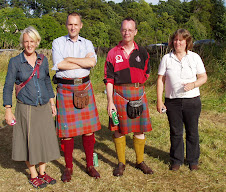I mentioned EZ’s idea of knitting a garter stitch strip as a facing. First I thought I’d do it, then I thought it was too much trouble. But last night, seeing how short the strips would actually have to be, I reinstated the idea.
I wonder a little bit if the neck is going to be uncomfortable. The yarn isn’t quite scratchy, but it’s sort of….firm; and necks are sensitive. I can easily take it out if need be and substitute something lower and boring. We’ll see.
When I had finished picking up, numbers carefully balanced left and right, I found that I had more stitches than required. The pattern just said “128”, for all sizes, without discussing how they were to be distributed. I had 146. I’ve left them. Too big is better than too small, for neck holes.
Comments
Holly, yes, it’s KnitPro DPN’s I’ve fallen for. Maybe when my slate is clear – pretty soon now – and I embark on new projects, I should keep a couple of days a week for socks. Ron said a couple of days ago that he knits a pair a month. Why not? I’m sure there’s nothing I knit that is more appreciated and more worn – they sometimes come back to me for darning -- and I now have lots of people to knit them for, one husband, eight children-and-children’s-spouses, three adult grandchildren.
When this yarn fast is over I am going to order sacksful of KF sock yarn. Like one of those diets where you can’t stand it any more and eat a whole chocolate cake.
(Kitchener Stitch)
Jeanfromcornwall, you’ve identified an odd aspect of the “Kitchener stitch” problem – until ten years ago or so, when the Internet made the whole world one, the phrase was unknown to British knitters.
I find, looking about a bit, that I wrote a whole blog entry about this question on August 15, 2006. And have done bugger all about it since then. Kim Salazar was working on it, too, but I can’t find her in my email address books. Trawling through my August, ’06, blog entries, I find a most frustrating reference to a scholarly comment from Franklin. Frustrating, because I can’t find the comment.
(Speaking of whom, we must all cut out and frame the full-page picture in the new IK. And, isn’t this year’s Knitter’s Olympic Gold Medal beautiful? It almost makes me wish I’d taken part. I trust I’ll be able to see it regularly on the Fishwife’s blog. Her entry – see February 27— is stunning, well deserving of a medal.)
Tamar, please elucidate your reference to Kitchener’s sister. Maybe we’re on to something, here.
My own theory, for what it’s worth, is that the phrase was resurrected in 1939- when knitters got to work for soldiers again, and although examples -- or near-examples, “Kitchener” without “stitch” -- can be found from earlier dates, it was only then that it really took off and became part of common speech.





I have been checking through all my copies of Woolcraft. They run from 3rd edition to 22nd edition with only minor gaps and that covers the years from pre 1918 to 1985. The only wording I can find is "cast off both needles together or graft the stitches"
ReplyDeleteSo no Kitchener to be found there.
I found this reference
ReplyDeletehttp://pocahontascofare.blogspot.com/2007/10/kitchener-stitch-tidbit-of-knitting.html
I wish the blogger had given a source for the information.
I found this
ReplyDelete"In addition to his military work, Lord Kitchener contributed to efforts on the home front. The knitted sock patterns of the day used a seam up the toe, that could rub uncomfortably against the toes. Kitchener encouraged British and American women to knit for the war effort, and contributed a sock pattern featuring a new technique for a seamless join of the toe, still known as Kitchener stitch"
This from http://en.wikipedia.org/wiki/Herbert_Kitchener,_1st_Earl_Kitchener
with footnotes referring to knitting books and blogs not what I would consider a "hard reference"
I was so excited to see Franklin in the new IK, too!
ReplyDeleteI'm not sure where I found the reference to Kitchener's sister. So far I've found most of the rest of it in posts to HistoricKnit yahoo group around January 15-17 or so, 2009. A discussion on alt.usage.english Dec2007 reported that Kitchener asked Queen Mary to organize citizens to make supplies. She set up Queen Mary's Needlework Guilds. Earliest references are to the Queen Mary toe and the Kitchener heel. There were Canadian newspaper references in Dec 1916 to Kitchener heel, and in Jan 1917 to Kitchener toe. By March 1918 the Kitchener toe was mentioned in Alaska.
ReplyDeleteP.S. a correction: the Dec 1916 reference was in a paper read at a meeting of American Sociologists, referring to the "Queen Mary toe" and the "Kitchener heel" as being familiar to everyone. The next reference is apparently a 1917 American Red Cross pamphlet "The War-Time Manual"; in Dec 1917 a comic poem referred to the "perilous Kitchener heel". The Alaska Railroad Record newspaper gave instructions for the Kitchener toe in Dec 1917. The Toronto Star mentioned the Kitchener toe on January 17, 1918.
ReplyDeleteIn February 1918 the Alaska Railroad Record inconsistently gave a sock pattern that called it 'weaving', then in March 1918 printed the Red Cross pattern calling it a Kitchener toe.
Since many of the comments in the past (including Franklin's) were lost in an ISP problem, people who want to keep this information should copy and paste it into a document of their own.
P.P.S. The volunteer groups doing knitting were called Queen Mary's Needlework Guild, Kitchener Clubs, Patriotic Leagues, Knitting Guilds, etc. She organized them 21 August 1914.
ReplyDeleteAnd oops, it was the Toronto Globe and Mail, not the Star, Jan 17, 1918. But the Star in 1930 had a reference to it, as a pattern everyone knew "during the war" but had forgotten again.